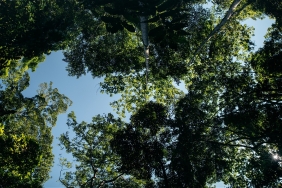JAVAN RHINO DEATHS, "NOT CAUSED BY INFECTIOUS DISEASES OR POACHING"
Jakarta. April 27, 2018. On Thursday, April 26, 2018, the Ministry of Environment and Forestry released news about the death of a Javan Rhino, an adult male identified as Samson. The identification was done by matching data from population monitoring conducted so far. Samson was found dead by Ujung Kulon National Park (TNUK) officers floating on Karang Ranjang beach, Karang Ranjang Resort, SPTN Region II Handeuleum Island, Ujung Kulon National Park.
Knowing this, the WWF Indonesia veterinary team based in Carita, namely Drh. Zulfikri and Drh. Gita Alvernita, along with Dr. Drh. Sri Estuningsih, M.Si, APVet, a pathologist from the Faculty of Veterinary Medicine of IPB, conducted a forensic investigation of the Javan Rhino carcass. As a result, on external observation, the condition of the rhino carcass is still intact, the horn is still attached to the head, there are no signs of injury to the body. The condition of the carcass showed that decomposition had occurred, characterized by the release of gas accompanied by foam from the rhino's skin gap, the skin and horn were easily detached. The eyes, mouth, nose, genitals and anus were red in color. Fly eggs and maggots were also found on the surface of the skin on the front and hind legs.
The results of internal observations (necropsy results) were discoloration of most organs (kidneys, lungs, days, spleen and intestines) that had undergone decay, characterized by the consistency of organs that were soft like porridge and discoloration of organs, and there was gas. In the thorax and abdominal body cavities, a large amount of transudate fluid was found. The intestine was found to be twisted between the small and large intestine causing rupture of the cecum. The intestinal contents were partially scattered on the serosa wall of the intestine, characterized by food residue attached to the intestinal serosa and body wall (peritoneum). Round worms were found in large numbers in the digestive tract. The team also took several organ samples that were still considered suitable for further examination at the Histopathology laboratory, Pathology Division of FKH IPB. "From the necropsy results, some organs were already in a destroyed state due to the decay process, such as the kidneys and lungs," Estu explained. He continued, "The initial conclusion is that the cause of death of this rhino is kholik or intestinal torsion, which means that the large intestine and small intestine are twisted (torso), resulting in damage to the large intestine, until the intestinal microflora bacteria produce toxins and then spread throughout the rhino's body."
The team also found no signs of acute infectious diseases caused by bacteria, viruses or parasites. Drh Kurnia Khairani, Project Leader WWF-Indonesia, Ujung Kulon office emphasized "Most importantly, this death was not caused by rhino poaching, because the horn is still attached to the rhino's body."
He continued, "The necropsy results stated that it was not caused by infectious diseases, which means it was not caused by dangerous infectious diseases such as anthrax and others". "We encourage the government to immediately finalize the 2018-2023 Rhino Conservation Strategy, and focus on developing a second population of Javan Rhinos other than in Ujung Kulon to prevent the extinction of Javan Rhinos caused by massive epidemic diseases, natural disasters such as tsunamis or earthquakes" continued Nia.
Infectious diseases that are epidemic in nature are feared to spread rapidly to the entire Javan Rhino population if the condition is only a single population, namely only in Ujung Kulon. Therefore, the development of a second population must immediately become a priority for future Javan rhino conservation strategies.
Samson's death is one of the population dynamics of Javan rhinos in the TNUK area. An important lesson learned from the death of "Samson" is that the handling of Javan rhino deaths is faster and more efficient than before. This rapid response is due to the existence of the Rhino Monitoring Unit and the Rhino Health Unit, which are the backbone of the management of the Javan rhino population in Ujung Kulon.
The coordination process of Balai TNUK with partners including WWF-Indonesia was able to respond quickly to the handling process starting from evacuation, forensic investigation involving experts from the University to the publication process as a form of accountability to the public.
-0-
Further information, please contact:
- Drh Kurnia Oktavia Khairani, Project Leader Ujung Kulon Program WWF-Indonesia
HP: 0813 1579 9857 | Email: kkhairani@wwf.id
- Diah R. Sulistiowati, Forest, Freshwater & Species Terrestrial Campaign Coordinator WWF-Indonesia
HP: 0811 100 4397 | Email: dsulistiowati@wwf.id





